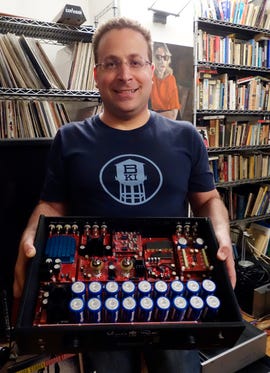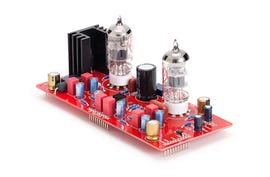
Vinnie Rossi
The Vinnie Rossi LIO Integrated Amplifier is a unique design, I’ve never seen or heard anything like it before. LIO is a modular component, so it can be configured to suit your needs when you buy it, and reconfigured down the road when your needs change.
Each section of the LIO Integrated Amplifier — the headphone amp, phono preamp, digital converter, etc. — sound better than what I’ve heard from other comparably priced integrated amps. All of the modules are powered by Vinnie Rossi’s patent-pending Pure-DC-4EVR ultracapacitor power supply that completely isolates LIO’s audio circuitry from your wall’s AC mains power.
I’m reviewing the Vinnie Rossi LIO Integrated Amplifier, but it’s also available as the LIO Preamplifier, and LIO Headphone Amplifier. All three LIO components look identical and measure 17.5 inches by 12 inches by 4 inches (44.5cm by 30.5cm by 10.2cm). They’re built in the US, and come with a 10-year warranty.
Since they’re modular designs you can start, for example, with a LIO Headphone Amplifier, later add a phono preamp module, or a power amp module to drive speakers. Swapping modules is easy enough, pop LIO’s top cover, plug-in the module, and put the cover back on and you’re good to go. My review sample of the LIO Integrated Amplifier had the headphone amp module, digital converter, phono preamp, vacuum tube stage, and the power amp for speakers module installed. Other modules are in the planning stages, and a wireless streaming module should be ready late this year.


Steve Guttenberg/CNET
The LIO Integrated Amplifier’s refreshingly simple front panel has just two knobs, the left one selects inputs, and the right one controls volume. The central display indicates volume level, source selection, etc. An all-metal, beautifully finished remote control is included with all LIOs.
With LIO in my system every album sounds different, as they all should, each one was recorded under completely different conditions, in different studios and recording gear, and with LIO those differences are laid bare.
Playing LPs over the LIO the sound is extremely clear, and yet at the same time vinyl surface noise, clicks, and pops recede into the background. That quieting was especially apparent when listening over headphones. I had great results with moving-magnet and moving-coil phono cartridges.
The Parasound Halo Integrated Amp’s sound was more laid-back and mellow, which I really liked, but the LIO’s purity of tone and higher resolution tilted the balance for me. That said, the Halo was far more powerful, so if that’s what you need the LIO will come up short. Pairing LIO with my KEF LS50s was a synergistic match, the little speakers projected a gigantic, deep and wide soundstage with Kronos’ “Early Music” album. The string quartet’s tone was brilliant, clear and sweet. These speakers always amaze me, but never more than this. LIO also clicked with my Zu Druid V speakers, the sound was refined and natural, with tremendous clarity.
The LIO Integrated Amplifier is rated at just 25 watts per channel, but it never came up short with the speakers I just mentioned, including the magnificent Harbeth Super HL5Plus monitors. Still, if you like to play music loud or your room is huge the LIO Integrated Amplifier’s limited power will be a deal breaker, so buy the LIO Preamplifier and use it with a separate, more powerful amplifier. Vinnie Rossi is working on a 150 watt per channel stereo power amp that’s the same size as the LIO; that one will probably debut late this year.


Vinnie Rossi
The LIO headphone amp’s clarity is beyond anything I’ve heard at home. The imaging is so big I sometimes had to take the headphones off just to make sure the sound wasn’t also coming from the speakers, it was not. The headphones just sounded more spacious with the LIO.
As for nitpicks, I have two: every few minutes as LIO switched between its two sets of Pure-DC-4EVR ultracapacitor banks I heard a subtle click sound coming from within the chassis, not from the speakers or headphones. Even so, I found the click slightly distracting. Also, the LIO doesn’t “remember” the input, USB for example, played last when you turned LIO off. When you turn it back on you always have to reselect the input. These are minor inconveniences, but Vinnie Rossi is working on correcting them.
Customers are encouraged to phone or email their questions and communicate directly with the man himself. That’s one thing that distinguishes Vinnie Rossi and some small high-end audio brands from more mainstream companies, customers can have one-on-one contact with the people who design and build their components (Vinnie’s wife Alexis also builds LIOs).
The Vinnie Rossi LIO Integrated Amplifier is available in black or silver finishes, prices start at $3,875 in the US. Vinnie Rossi sells direct in the UK and Australia for the same price in US dollars, with a 30-day return policy and no restocking fees. LIO prices are set to significantly rise on August 1, 2015.




